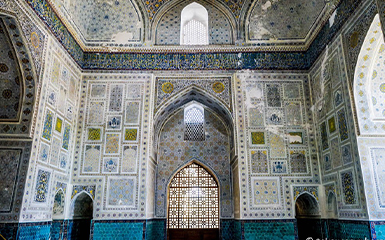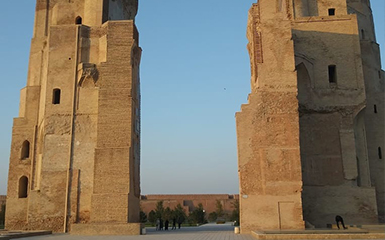Bahauddin complex
Char Minar
Lyab-I Hauz complex
Poi Kalan complex
The Ark Citadel
Bolo Haouz Mosque
Kalan Minaret
Islam Khodja complex
Itchan Kala
Kalta Minaret
Kunya Ark
Kutlugmurat Anak
Alla Kuli Khan
Muhammad Rahim Khan
Muhammed Emin Khan
Pahlawan Mahmud
Tash Hauli
Juma Mosque
Andijan
Muynak
Rabati Malik
Shahrisabz, green city, is a city of Uzbekistan, native land of Tamerlane, located to the south of the city of Samarkand. Its old name was Kesh.
The historic centre of Shakhrisabz has exceptional monumental buildings and old districts testifying to the secular development of the city, and especially its heyday, under the reign of Tamerlan (Amir Timur) and the Timurids, from the fifteenth to the sixteenth century. Since 2000, Shakhrisabz is part of the UNESCO world heritage.
Formerly known as Kash, Shahrisabz is one of the oldest cities in Central Asia. It was founded over 2,700 years ago. From life to the 4th century it was part of the Achaemenid Empire.
Ptolemy, general of Alexander the Great, captures Bessos there, the satrap of Bactria and pretender to the throne of Persia, thus putting an end to the Achaemenid Empire. Alexander the Great spent some winters in Kash; there he met his wife Roxane in 328-327 BC.
In 710 the city was conquered by the Arabs.
Shahrisab, is the name Tamerlan gave to ancient Kash where he was born on April 9, 1336. During the early years of the Timurid dynasty, the city was a popular place; however, during the Timurid period the focus of activity shifted to Samarkand.
According to legend, the Khan of Bukhara Abdullah Khan II destroyed the city in a fit of anger following the death of his horse, due to exhaustion, as he approached the city.
To the north of the small village of Kumyrtepa in the Kitab district of the Kashkadarya region, on the left bank of the small shallow river Shurabsai, which originates from the Zarafshan mountains, from north to south 3 tepa of various configurations alternate, which together make up 3 parts of the ancient capital city of Nautak are Padayataktepa, Uzunkir and Sangirtepa.
Padayataktepa is the citadel of the city with an area of 270 × 74 m. It is located in the northern part on the high steep bank of Shurabsai. As a result of archaeological work at the site, 4 building horizons were traced. The oldest cultural layers of the settlement date back to the 9th-8th centuries BC.
Uzunkir - the remains of the city's fortress wall. At one time, the wall surrounded the territory of the entire city with an area of more than 70 hectares. The original wall of the settlement was built of bun-like adobe bricks from the 10th-9th centuries BC. Later, during the reign of the Achaemenid, Seleucid and Greco-Bactrian kingdoms, large-scale repair work was carried out on the city walls.
Sangirtepa is a detached hill located outside the city walls, 650 m south-west of Uzunkir. Consists of a central hill with an area of 84 × 62 m and a height of about 8 meters. The bypass wall covers an area within 3 hectares. As a result of archaeological excavations at Sangirtepa, a unique Zoroastrian temple with a hall in the middle, an altar and auxiliary rooms was uncovered. The temple is one of the most ancient places of worship in Central Asia.


